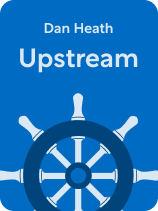

This article is an excerpt from the Shortform book guide to "Upstream" by Dan Heath. Shortform has the world's best summaries and analyses of books you should be reading.
Like this article? Sign up for a free trial here.
Do you feel like you have endless fires to put out—in your personal life, at work, and in society as a whole? What if you could work at the root of the problem instead, preventing crises from happening altogether?
In his book Upstream, Dan Heath explains how reactive solutions (for which we have a bias) aren’t nearly as effective as proactive, long-term solutions. He calls these upstream solutions, and he provides advice on how to implement this type of problem-solving.
Keep reading for an overview of this book that aims to help you solve problems before they happen.
Overview of Dan Heath’s Book Upstream
In his book Upstream, Dan Heath concedes that the concept of working on the root causes of problems is not always the easiest route. But, it does offer the potential for improving flawed systems and reducing harm on a broader scale. For example, he explains that, instead of disproportionately spending resources on things like chronic illness and invasive surgeries, people would be better off if we prevented them from getting sick in the first place.
(Shortform note: Although extensive research has been conducted on the benefits of preventive health care, there are still many barriers to preventive care in the US: the cost (and lack) of health insurance, not having a primary care doctor to see regularly, living far from a health center, and lack of awareness of preventive services. On the institutional side, funding for health services and payments to health providers are often linked to the number of treatments rather than the overall health of patients.)
Heath is a Senior Fellow at Duke University where he directs a program on social entrepreneurship. He and his brother Chip co-authored four New York Times best-seller business books: Switch, Made to Stick, Decisive, and The Power of Moments. In 2013, Thinkers50 named him one of the world’s most influential business management thinkers. In Upstream (published in 2020), Heath takes a detour from his usual business management topics to apply his idea of upstream thinking to many different contexts so that anyone can incorporate it into their life.
We’ll start by explaining why Heath thinks society needs upstream solutions to solve pressing problems both big and small—from eliminating day-to-day inconveniences to preventing climate crises. Then, we’ll explain why people and institutions are generally biased toward more straightforward, reactive solutions. Next, we’ll describe Heath’s advice for successfully implementing upstream solutions as well as some challenges to look out for as you carry out the advice.
Upstream Solutions
First, let’s define what Heath means by “upstream” thinking. In the central metaphor of the book, there’s a crisis happening at a specific point along a stream.
On the other hand, Heath would argue that a better strategy is to walk upstream to identify the source of the problem: Where is all the trash coming from? Who is putting it there and why? Heath suggests that identifying the source of problems enables us to create more effective and longer-lasting solutions.
Heath explains that the term “upstream” is more suitable than “proactive” or “preventive” because the metaphor represents the opportunity to get continually closer to root causes. In other words, it’s not just about ending one cause-and-effect cycle but being able to endlessly zoom out to see the bigger picture and identify key points where something might be going wrong.
Why We Need Upstream Solutions
Heath argues that people should always strive for upstream solutions because they tend to have longer-lasting benefits and provide opportunities to reduce human suffering.
Problems related to climate change illustrate this theory well.
One way to deal with this—the reactive solution—is to wait until it happens. And, if it does, try to relocate those communities farther inland. This solution deals with the problem but only at the expense of many innocent lives. On the other hand, people could go upstream by reducing the atmospheric carbon emissions that drive climate change or by changing the economic incentives that drive the use of carbon-emitting energy sources. Heath would argue that the upstream solution provides a more hopeful possibility of preventing the catastrophe altogether and providing long-term safety from climate change-related disasters.
Heath makes the key point that upstream solutions will often save individuals and institutions money in the long run. However, cost-effectiveness shouldn’t be a prerequisite for upstream actions because we have a moral obligation to reduce human suffering whenever possible.
Bias Toward Reactive Solutions
Now that we’ve covered what upstream solutions are and why they’re advantageous, we’ll explain the key reasons why people are generally biased toward reactive solutions. Heath writes that reactive solutions are often more tangible than upstream actions. He also explains that urgent scarcities prevent people from thinking about long-term solutions, and many pervasive problems become normalized over time.
Reactive Solutions Are More Tangible
Heath writes that reactive solutions tend to be more tangible because they imply that there’s already a specific and immediate problem to be addressed.
Heath asserts that it can be hard to measure what didn’t happen as a result of upstream thinking, like knowing how many awkward social interactions between housemates were avoided by taking preventive action. Heath suggests that intangible benefits like this make it more difficult to recognize the advantages of upstream action.
Urgent Scarcities Hinder Long-Term Thinking
Heath claims that the second reason why people are biased toward reactive solutions is that urgent problems blind us to long-term solutions. He cites research showing that in conditions of scarcity, like not having enough time to get everything done, people involuntarily narrow their focus around the scarce resource. Heath writes that in these situations, people are psychologically unable to make sensible decisions to manage their time better in the future because all they can think about is how to juggle all of their urgent tasks from moment to moment.
Communities Normalize Widespread Problems
Lastly, Heath explains that people favor reactive solutions because when a problem becomes pervasive, people naturally adapt to the situation and normalize it.
Heath writes that people forget that they have the agency to avoid many problems. Furthermore, even if a problem impacts people broadly, there’s often no single actor with clear and sole ownership over resolving widespread societal crises such as health epidemics.
Advice for Upstream Intervention
Given these cognitive biases toward reactive thinking, how can people intentionally foster an upstream mindset? In this section, we’ll describe Heath’s recommendations for implementing upstream solutions in any context. We’ve consolidated his advice into three key points: Gather people with a shared interest, reform systems by identifying small tweaks that can produce significant change, and use data to guide experimentation.
Gather People With a Shared Interest
The first important step for upstream intervention is gathering a team of people who can tackle the problem from many angles—a process Heath calls “surrounding the problem.” Heath argues that diverse people with a shared interest can make a big difference when they align their efforts toward a common goal. He claims that if there’s nobody with explicit responsibility over a problem, it’s up to individuals to take on the challenge and recruit others who are motivated and empowered to help.
Identify Small Changes With Significant Impacts
Heath’s next piece of advice builds on the group of people who are invested in reform: Change systems rather than reacting to byproducts of bad systems. He recommends achieving this by targeting opportunities to make minor changes that have a disproportionately large impact on the problem (what Heath calls “leverage points”).
Use Data to Experiment Continuously
Heath’s third component of upstream intervention is using data to guide and tweak experimental solutions. The benefits of upstream problem-solving are not always immediately obvious. Heath writes that in some areas—like preventive health care or changing a relationship dynamic—it could take years to see a significant change in outcomes. As a result, it’s important to be patient with the process and identify relevant metrics that you can continuously monitor to ensure that you’re headed in the right direction.
Heath contends that ample data allows you to not only identify early warning signs of a problem—to avoid being forced to react rather than prevent—but also allows you to track progress toward a goal and improve your strategy.
An increase in the volume of non-biodegradable materials purchased locally might serve as an early warning sign that the problem will get worse, assuming that the prevalence of these materials contributes to the littering crisis. Heath suggests that trends in these areas could indicate success for the various stakeholders or indicate a need to change course. He emphasizes that you don’t have to predict the best solution from the beginning, you just have to respond accordingly to what the data shows.
Challenges of Upstream Work
Now that we’ve covered the three key aspects of upstream problem-solving, we’ll describe some of the challenges that Heath says to look out for as you implement these strategies. These potential roadblocks include metrics that falsely indicate success (what Heath calls “ghost victories”), unintended consequences that exacerbate the initial problem, and a mismatch between the people who contribute to solutions and those who benefit from them. In this section, we’ll describe these common challenges in more detail.
Data-Related Problems
Heath contends that there are multiple ways for data to fall short when it comes to accurately indicating the success of upstream efforts. Therefore, it’s important to constantly reevaluate the metrics you’re using to measure progress. The first potential problem with data occurs when an overall trend driven by external factors gives the illusion that your specific efforts are driving change.
Heath writes that the second data problem arises when the metrics for tracking upstream intervention don’t align with the overall goal. Lastly, Heath explains that a metric for short-term efforts can morph into the end goal rather than a means to a larger change. Heath suggests that one potential solution to this challenge is to pair two complementary metrics together to ensure that you’re moving toward the initial goal.
Unintended Negative Consequences
Heath warns that, in addition to challenges related to data, there can also be unintended negative consequences of upstream intervention.
Heath’s solution to this challenge is staying vigilant to unintended outcomes and adjusting your strategy when the need arises.
Mismatch in Contributors and Beneficiaries of Upstream Change
The last challenge of upstream work that Heath discusses is a mismatch between the people who are empowered to do the upstream intervention and those who benefit from those solutions. Heath writes that upstream intervention often requires costly or time-consuming initiatives, and it might not always seem worth it for people to make the effort or investment.
Heath explains that, to combat this challenge, it’s important to ensure that everyone involved in the upstream efforts has a vested interest in the overall goal, whether it’s financial, moral, or ideological. This also applies when an organization or business has to provide financial investment for upstream work and the monetary return on their investment is not guaranteed.

———End of Preview———
Like what you just read? Read the rest of the world's best book summary and analysis of Dan Heath's "Upstream" at Shortform.
Here's what you'll find in our full Upstream summary:
- Why you need to get to the root of a problem rather than applying band-aids
- Guidelines for implementing upstream solutions to solve problems
- How to solve problems before they happen






